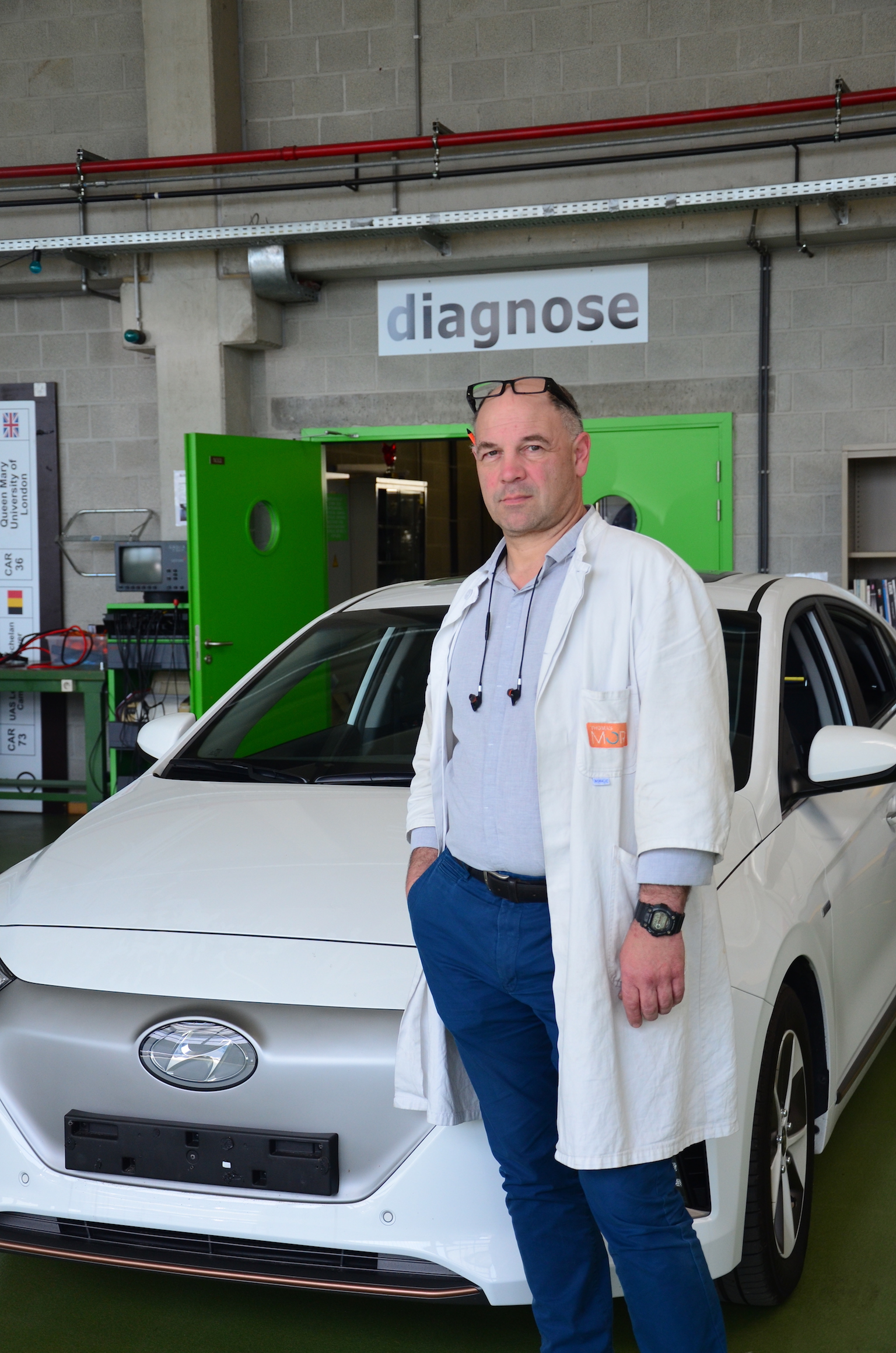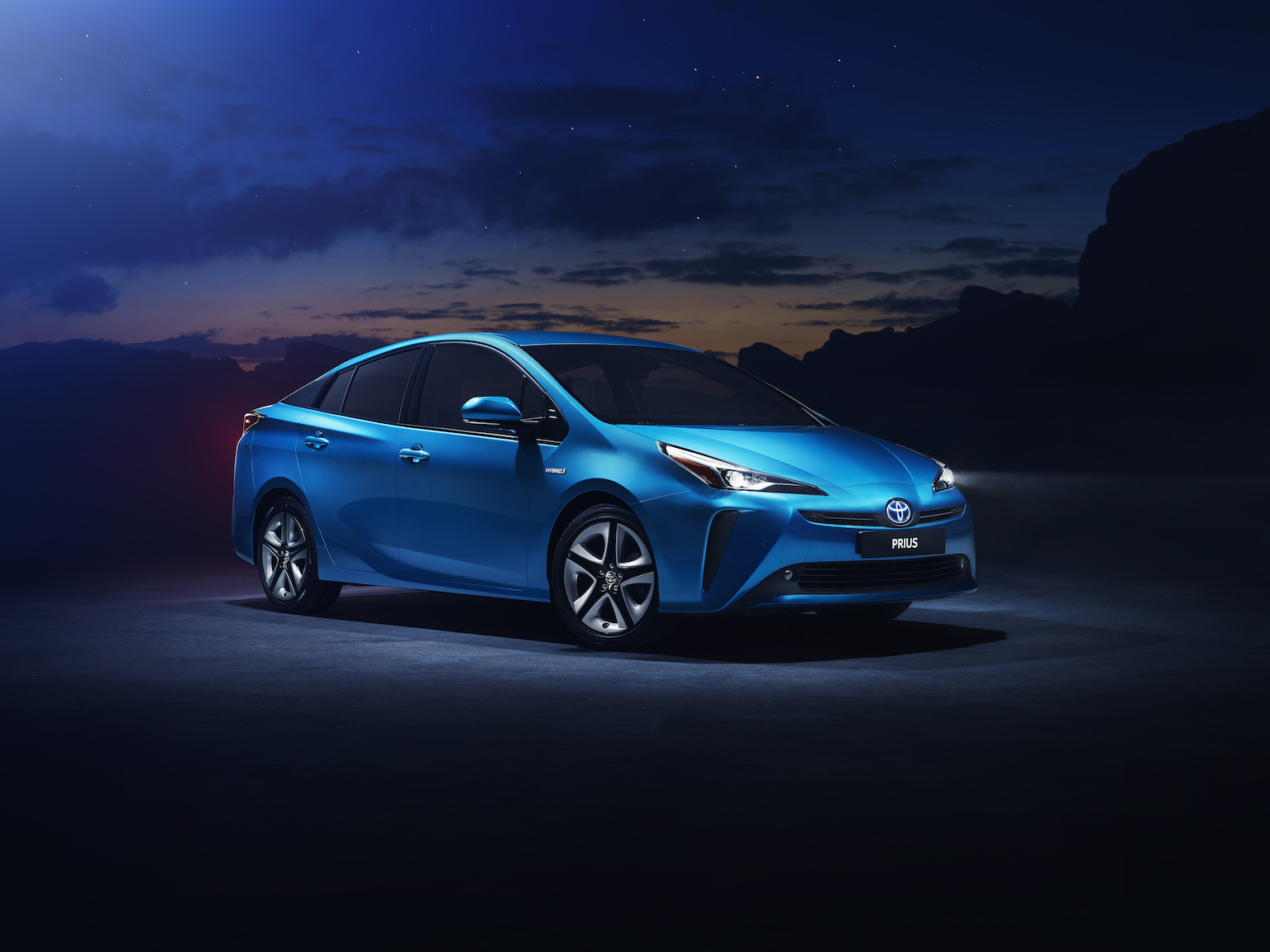With more and more car brands now announcing to stop the production of diesel cars, and with Belgium now being one of the first Western European country where autonomous cars are allowed on the public roads, our streetscape starts looking completely different. We asked Mark Pecqueur, teacher and researcher of Autotechnology at Thomas More Hogeschool and Aurélie Gerth, spokesperson of the world’s largest self-charging hybrid car builder.
Text Anja Van Der Borght
Mark Pecqueur, researcher of Automotive Technology at the Thomas More Hogeschool: “Tesla is so iconic and distinctive that if it threatens to go down tomorrow, a long queue of candidates will be standing in front of Elon Musk’s door to take over the company. Everyone wants to buy Tesla and I think the Chinese will succeed in doing just that “
 Mark Pecqueur, teacher and researcher of Autotechnology at Thomas More Hogeschool
Mark Pecqueur, teacher and researcher of Autotechnology at Thomas More Hogeschool
In which propulsion form do you see the most future now that diesel is anything but popular and more alternative power trains are needed?
MP: “Whatever application, it is important that virtually no rare raw materials are used. If we are going to drive electrically in the future, we will need a lot of batteries and we will encounter a shortage of rare materials. That is why we are looking for a zero emission solution which is free of rare materials or uses it in such small quantities that they cannot restrict its growth. Today there are 3.5 million electric cars worldwide, within a total of approximately 1.2 billion cars. Already now we are asking ourselves how we will address that raw material shortage when tomorrow there will be 500 million. We can recycle these raw materials, but the cost of recycling is often much higher than the current raw material price. So before it becomes economically viable to do recycling, the raw material price has to go up first. Everyone assumes that the cost price of a battery will have dropped to $ 100 per kilowatt hour of storage by 2025. Today we pay 220 dollars. Exactly 64 percent of that amount is spent on materials. If we want to achieve the target of the 100 dollar, we must already look for other materials. That is why we ask ourselves whether it is interesting to continue using this technology for electric vehicles. “
Some opponents of certain technologies focus on efficiency but this energy efficiency would not be altogether relevant?
MP: “If you add all the installed power to all power plants, cars, trucks, airplanes, in short, everything that now uses energy … then the world has 15 terawatts of installed power today. The perfect alternative must therefore be able to develop these 15 terawatts. Classics such as biofuels or hydropower can each generate only 7 terawatts. Geothermal energy yields 44 terawatts and wind power not less than 72 terawatts. We can therefore run the whole world on geothermal or wind energy, but don’t forget that the sun produces 85,000 terawatts. So if you capture one percent of the solar energy, you can do everything we do now in this world, with an efficiency of just two percent. So there is no problem with the availability of the basic energy, but there is a shortage of rare materials such as lithium, cobalt, platinum, etc. which we need to make the batteries to store that energy. Now when efficiency because of the abundance of solar energy does not play an important role, you can use that electricity – because all renewable energy comes in the form of electricity – to make hydrogen for example, which you can then use in vehicles. However, hydrogen is a very rarefied gas that is now stored by hydrogen vehicles under a pressure of 700 bar. And that’s a lot. But here too, other techniques are possible. For example, we could combine that hydrogen with CO2 from the air to make methanol – a safe liquid. Opponents point to the loss of efficiency, which is indeed there, but this energy loss does not play a role because as we said, there is plenty of solar energy around, and it is free. So we mainly look for solutions which avoid the use of rare raw materials and then we end up with hydrogen, used for example in internal combustion engines which, unlike fuel cells, do not require rare materials. A combustion engine running on hydrogen is also synonymous with zero emission. Methanol made on the basis of hydrogen and CO2 indeed releases CO2 when it is bruned, but as you have initially also taken CO2 out of the atmosphere to manufacture methanol and the combustion itself can be reduced to zero emission if necessary. We can apply these techniques to 1 billion vehicles without a shortage of rare raw materials throwing a spanner in the works.”
Mark Pecqueur, researcher of Automotive Technology at Thomas More University of Applied Sciences: “China has long ceased to be a society which merely copies our technologies. They are already much further than we are, but the Western car world apparently does not want to see that.”
Belgium is a diesel country. How do you see this technology evolving now that many car brands have announced that they will stop the production of diesel cars?
MP: “Diesel is just like gasoline a fossil fuel and it’s finite. Does this mean that we are going to switch very quickly? I am not convinced of that. New diesels meet the latest Euro 6D Temp emission standard and today most diesel engines emit – less contradictory – less NOx than petrol engines. NOx emissions are a real problem and moreover our governments do not succeed in limiting fraud. And I am not talking about Dieselgate, but about soot filters that are being removed or the numerous cases where other engine management software is installed – and that has nothing to do with the manufacturer – so that this particular car emits forty to fifty times more than a car that meets that standard. One of our studies shows that in Belgium at least 50,000 cars drive around without a particulate filter and without after-treatment. If you then know that those cars certainly emit forty times more than allowed, than it is easy to calculate that they emit more than 2.5 million cars that meet the standard. That is madness and something has to be done about it! I am also convinced that diesel will not disappear because of technological limitations, but because the customer is otherwise orientated. If the mass customer buys something differently tomorrow, the barrel is finished. And I think we are in that phase right now. It may also well be that the market is changing due to totally new players that we do not know yet. “
New players we do not know yet? What do you mean?
MP: “The biggest car manufacturer today is no longer Germany, but China and the big problem is that we do not look at China but they do look at us. They are constantly wondering how they will tackle the Western car market. If tomorrow the biggest car manufacturing nation starts to focus on Europe, then very quickly, many hitherto unseen brands will enter our market. We have already experienced it. First to come were the Japanese, then the Koreans but they were small beer compared to the Chinese who can claim a dominant role in our car market in three to four years time. The first signs are already there. Geely bought Volvo when it had serious financial problems, but Geely also bought ten percent shares of the Daimler group this year and is therefore owner of Mercedes for ten percent. I am sure that every morning in China people are waking up which have the daily task to purchase Daimler shares without affecting the market value. Within a few months or a few years the Chinese will come up with thirty percent shares and they can also appoint the CEO. Why? Brand products are all important to the Chinese and Daimler with the star of Mercedes is almost the icon of the Western car world. If you can put that logo on your portfolio tomorrow, people who no longer associate Chinese cars with Chinese products, and see only a top quality product, Mercedes. This trend can go very fast and I have the impression that the car world is apparently not aware of it in Europe or still is convinced these developments will not be this fast. Well, nobody thought the Apple smartwatch would be very successful. In a few years, Apple has become the market leader in wrist watches. In the last months of 2018 it sold more watches than the entire Swiss watch industry combined. “
Cars from China are those electric, hybrid or …?
MP: “China today has the largest number of mines in the world, and because China manages these rare raw materials, it mainly focuses on electricity today. China has long ceased to be a pure copier of our technologies. They are already much further than we are, but the Western car world does not want to see that. If the Chinese throw in their engineering power and they contol the supply of rare materials, electric driving will mainly mean that we are fully committed to China and that we will actually transfer a lot of our economy to China. I have absolutely nothing against China but we have to deal with it smartly. When China wanted to invest two years ago in our electricity grid operators, spirits went to the roof here. But what is the alternative? I’m not going to say that we should give them free access, but limiting their entry in our markets is not a good strategy because we cannot stop them. So we better work together.”
Elon Musk, CEO of Tesla, has understood that well?
MP: “In the era before Tesla, electric cars were dead ducks with low performance. Tesla changed that with a well-designed car with enormous performance. Musk was also the first to bring a gigantic tablet touchscreen and connectivity into the car’s cabin. In short, Tesla has been very innovative and will be innovative for a long time, but Musk also collides with the scarcity issue of rare raw materials. Last year he had the plan to buy a mine, but he returned empty handed. At the door of every lithium mine where he knocked, a Chinese opened. The Chinese have then proposed to Tesla to build its next mega battery factory in China. And that is happening now. China holds the key in electric driving because they control the supply of rare materials. To find methods to develop electric driving without using rare materials is particularly difficult.”
 The Yaris Hybride is for years now the cheapest hybrid on the market. Photo: Yassine Hannati
The Yaris Hybride is for years now the cheapest hybrid on the market. Photo: Yassine Hannati
Why do you think hybrids are the future?
MP: “Hybrids are the lowest stepping stone for anyone who thinks of driving electrically. You can drive 60 to 70 kilometers on electric power – especially with a plug-in hybrid – which is still sufficient for most people and if you still want to go further than you just start up your combustion engine and drive carefree. I see a very large market for hybrid cars, just like for small electric cars. Electric propulsion is typically conceived to be used in the cities and you do not need a big car. Microlino will be on the market next year with an incredibly clever concept inspired by bubble cars like the BMW Isetta from the fifties. The Swiss Microlino runs up to 90 km / h and has an autonomy of 200 km with a battery of 14.4 kilowatt hours. But keep in mind that the big jump in automotive transport will not come from electric driving but from autonomous driving. Belgium is now and then also the first one. We have been the first country in Western Europe since 1 May where you can enter the public road with an autonomous car – provided you tackle the necessary paperwork mountain. We have the opportunity to make a difference in that area, but then we also have to do it. Mary Barra, CEO of General Motors, will present the Chevrolet Bolt at the CES fair in Las Vegas in January, an autonomous car. Those cars will be on the market in the coming years. And then it is waiting until they become the standard mode of transport. “
Which hybrid determines the future: the plug-in or the self-charging?
Since hybrid cars are the near future for many mobility experts, we also met with Aurélie Gerth, spokesperson of Toyota-Lexus, the world’s largest hybrid car manufacturer.
 Aurélie Gerth, spokesperson of Toyota-Lexus, the world’s largest hybrid car manufacturer
Aurélie Gerth, spokesperson of Toyota-Lexus, the world’s largest hybrid car manufacturer
Toyota pioneered (plug-in) hybrid and hydrogen, but what drive do you think is the alternative propulsion mode of the future?
AG: “For years, Toyota has been convinced that every drive has its usefulness and place in the market. Electric propulsion for small vehicles and short distances. (Plug-in) hybrid for medium-sized vehicles and mixed use and hydrogen for large vehicles such as vans, buses, trucks and for longer distances (see diagram). In the meantime, hydrogen technology is also being developed so that you can refuel your hydrogen quickly and safely and you have a large autonomy. Now it is only waiting for enough hydrogen stations.”
 The new Toyota Prius 2019
The new Toyota Prius 2019
There is a big difference between plug-in hybrids and self-charging hybrids. Why does Toyota mainly focus on the latter?AG: “Toyota is a pioneer in the construction of hybrids, plug-in hybrids and hydrogen cars and although we will introduce electric cars in China from 2020 onwards, we will only consider to build them on a large(r) scale when electric cars become affordable and when production of batteries requires less rare raw materials, the battery is less heavy, has a greater autonomy and charges faster. For electric driving to break through there is also still a lot of work to be done around the creation of sufficient charging options and harmonization of standards. That is the reason why we at Toyota are convinced that self-charging hybrids will be a very important alternative in the coming years. Toyota is also the reference for affordable, practical self-charging hybrids. Of all the cars Toyota sells in Europe, 47 percent are hybrid. In Belgium this share is 56 percent. No other manufacturer can provide such figures. For the time being, we are marketing only one plug-in hybrid, the Prius Plug-In Hybrid, because although we invented the plug-in hybrid, studies show that the average consumer has not yet developed the habit of regularly recharging his plug-in hybrid. Consequently he uses the combustion engine too often and the design of the car misses its purpose. We really strive for zero emissions and therefore prefer the regular self-charging hybrids with which the customer – as studies have shown – drives more than 70 percent of the time electrically. “


